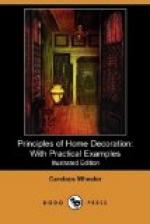I will give still another dining-room as an example of colour, which, unlike the others, is not modern, but a sort of falling in of old gentility and costliness into lines of modern art—one might almost say it happened to be beautiful, and yet the happening is only an adjustment of fine old conditions to modern ideas. Yet I have known many as fine a room torn out and refitted, losing thereby all the inherent dignity of age and superior associations.
A beautiful city home of seventy years ago is not very like a beautiful city home of to-day; perhaps less so in this than in any other country. The character of its fineness is curiously changed; the modern house is fitted to its inmates, while the old-fashioned house, modelled upon the early eighteenth century art of England, obliged the inmates to fit themselves as best they might to a given standard.
The dining-room I speak of belongs to the period when Washington Square, New York, was still surrounded by noble homes, and almost the limit of luxurious city life was Union Square. The house fronts to the north, consequently the dining-room, which is at the back, is flooded with sunshine. The ceiling is higher than it would be in a modern house, and the windows extend to the floor, and rise nearly to the ceiling, far indeed above the flat arches of the doorways with their rococo flourishes. This extension of window-frame, and the heavy and elaborate plaster cornice so deep as to be almost a frieze, and the equally elaborate centre-piece, are the features which must have made it a room difficult to ameliorate.
I could fancy it must have been an ugly room in the old days when its walls were probably white, and the great mahogany doors were spots of colour in prevailing spaces of blankness. Now, however, any one at all learned in art, or sensitive to beauty, would pronounce it a beautiful room. The way in which the ceiling with its heavy centre-piece and plaster cornice is treated is especially interesting. The whole of this is covered with an ochre-coloured bronze, while the walls and door-casings are painted a dark indigo, which includes a faint trace of green. Over this wall-colour, and joining the cornice, is carried a stencil design in two coloured bronzes which seem to repeat the light and shadow of the cornice mouldings, and this apparently extends the cornice into a frieze which ends faintly at a picture-moulding some three feet below. This treatment not only lowers the ceiling, which is in construction too high for the area of the room, but blends it with the wall in a way which imparts a certain richness of effect to all the lower space.
The upper part of the windows, to the level of the picture-moulding, is covered with green silk, overlaid with an applique of the same in a design somewhat like the frieze, so that it seems to carry the frieze across the space of light in a green tracery of shadow. The same green extends from curtain-rods at the height of the picture-moulding into long under-curtains of silk, while the over-curtains are of indigo coloured silk-canvas which matches the walls.




